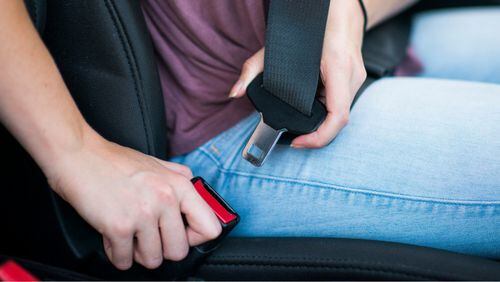Sunshine in the middle of last week obliterated both the cloud cover and the lighter-than-normal traffic conditions around metro Atlanta. We predicted in the previous column that it would. Unfortunately, the last few days on our city’s roads have seen vicious wrecks and long delays and we pray for those involved. And we have covered time and again the different driving habits, behaviors and attitudes that can both cause and prevent these snarls.
There are also some insidious driving tics that can wear away at our physical well-being. Incorrectly positioning ourselves, the seat, the steering wheel, seat belts, head restraints and mirrors can cause long-term pain. Improper posturing of those things can also increase the chances of injury and delayed reaction time in crashes.
Focusing first on everyday, incident-free driving, small errors in the positioning of the arms and the seat can aggravate the body over long amounts of time.
I reached out to Dr. Jonathan Mathers of Piedmont Orthopedics/OrthoAtlanta about proper positioning in the car. I started with Mathers since he recently has seen me for minor, chronic neck, shoulder and knee pain that my poor posture has caused. He pointed me to some standard literature that he and his team use when instructing drivers.
Drivers should recline seats only 10 to 15 degrees from the straight up-and-down position and should sit as far back in the seat as possible. The real finesse is positioning the hands and the elbows. Mathers and his team recommend holding the steering wheel at a “9 a.m. and 3 p.m.” position, instead of the long-taught ”10 and 2″ alignment. With the elbows at 120 degrees, which is halfway between straight up and straight forward, driving and sitting this way allows one to take the stress off the shoulders and neck. That tension, over long periods of time, creates pain and problems.
Mathers also advises drivers to adjust the seats far enough back to not brush against the steering wheel and dashboard, but close enough to not stretch to have to reach the wheel and the pedals. A strain leads to pain.
If a driver has a lumbar support in the seat, they should adjust it to be just firm enough to fill the small of the back.
And, Dr. Mathers says, seat belts should not be so tight and high as to impinge the neck. The shoulder belt should go across the chest and the lap belt across the upper thighs. This is very important and a driver should raise or lower the seat to fit themselves into the belts correctly.
Occupational maneuvers in the driver’s seat can pile up into future pains. But being part of a pile-up in any moment can cause instant agony. AAA recommends drivers and passengers sit at least 10 inches back from the steering wheel and dashboard, to decrease injuries from airbags. They also agree with Mathers in the positioning with the wheels and pedals, adding that handling these properly decreases physical fatigue and increases precision in both steering and pedaling. Acuity is key when split-second decisions can determine life and death.
All of these adjustments also decrease the risk of injuries in a wreck. Wearing seat belts properly keeps people squarely in place and slows a body’s deceleration during a front-end crash. This increases the rate of survival in a crash by 25% and decreases the injury risk by 50%, AAA says.
Head rests or head restraints, as AAA more properly calls them, are critical to safety and often disregarded. Head restraints stabilize the head during an impact and reduce whiplash in rear-end collisions. They also help decrease upper body and neck injuries in frontal wrecks. But people have to use them correctly, fixing the head restraints within three inches of the back of the head when sitting up straight. About 60-85% of drivers do not have head restraints positioned properly, AAA reports.
Motorists also need rear-view mirrors set properly, as to show the entire rear window. AAA says drivers shouldn’t have to move their head to fully see behind them — just their eyes. Drivers should also set the side mirrors wide, as to barely be able to see the sides of their own cars in them. These adjustments give the fullest view around the car in all directions and help prevent odd strains of the neck and head when checking those mirrors.
Everything done behind the wheel requires more attention than we normally give it. I, for one, have loved sitting way back and low in my driver’s seat for years. Only recently, after the doctor’s visits and a great talk with my thoroughly driver-educated wife, Momo, did I begin making these adjustments. I’ve needed a reset and many of us should also consider one.
Every one of the above recommendations helps both short- and long-term health and safety in the car. But, despite all of it, Mathers states the inevitable: sitting anywhere for a long time causes problems. Drivers should take frequent breaks on long trips to decrease pain and stiffness, he said. That habit will give a whole new meaning to “bio break” on the next road trip. Drive safely.
Doug Turnbull, the PM drive Skycopter anchor for Triple Team Traffic on 95.5 WSB, is the Gridlock Guy. He also hosts a traffic podcast with Smilin’ Mark McKay on wsbradio.com. Contact him at Doug.Turnbull@cmg.com.
About the Author






